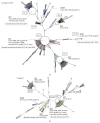Molecular Epidemiology of Invasive Listeriosis due to Listeria monocytogenes in a Spanish Hospital over a Nine-Year Study Period, 2006-2014
- PMID: 26539467
- PMCID: PMC4619764
- DOI: 10.1155/2015/191409
Molecular Epidemiology of Invasive Listeriosis due to Listeria monocytogenes in a Spanish Hospital over a Nine-Year Study Period, 2006-2014
Abstract
We investigated the pathogenicity, invasiveness, and genetic relatedness of 17 clinical Listeria monocytogenes stains isolated over a period of nine years (2006-2014). All isolates were phenotypically characterised and growth patterns were determined. The antimicrobial susceptibility of L. monocytogenes isolates was determined in E-tests. Invasion assays were performed with epithelial HeLa cells. Finally, L. monocytogenes isolates were subtyped by PFGE and MLST. All isolates had similar phenotypic characteristics (β-haemolysis and lecithinase activity), and three types of growth curve were observed. Bacterial recovery rates after invasion assays ranged from 0.09% to 7.26% (1.62 ± 0.46). MLST identified 11 sequence types (STs), and 14 PFGE profiles were obtained, indicating a high degree of genetic diversity. Genetic studies unequivocally revealed the occurrence of one outbreak of listeriosis in humans that had not previously been reported. This outbreak occurred in October 2009 and affected three patients from neighbouring towns. In conclusion, the molecular epidemiological analysis clearly revealed a cluster (three human cases, all ST1) of not previously reported listeriosis cases in northwestern Spain. Our findings indicate that molecular subtyping, in combination with epidemiological case analysis, is essential and should be implemented in routine diagnosis, to improve the tracing of the sources of outbreaks.
Figures




References
-
- EFSA Panel on Biological Hazards (BIOHAZ) Scientific opinion on a review on the European Union Summary reports on trends and sources zoonoses, zoonotic agents and food-borne outbreaks in 2009 and 2010—specifically for the data on Salmonella, Campylobacter, verotoxigenic Escherichia coli, Listeria monocytogenes and foodborne outbreaks. EFSA Journal. 2012;10(6, article 2726) doi: 10.2903/j.efsa.2012.2726. - DOI
Publication types
MeSH terms
LinkOut - more resources
Full Text Sources
Other Literature Sources
Medical

